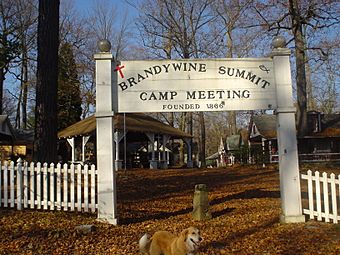Brandywine Summit Camp Meeting facts for kids
The Brandywine Summit Camp Meeting is a special historic place in Concord Township, Delaware County, Pennsylvania. It's like a small village that was built for religious gatherings. People would come here to attend outdoor church services and stay for a few days. This area is now recognized as a national historic district. This means it's an important place that helps us understand the past.
Contents
What is a Camp Meeting?
Imagine a time before cars and easy travel. People lived far apart, and it was hard to gather for big events. Camp meetings were popular ways for many people to come together. They would meet outdoors for several days. People would listen to sermons and sing songs. They often slept in tents or small cabins. It was a mix of a spiritual retreat and a community gathering.
History of Brandywine Summit
The Brandywine Summit Camp Meeting started around 1884. It was built by John Wise and others. Over time, it grew into a community. People built small cottages where they could stay. This allowed them to attend the meetings comfortably. The area covers about 13 acres. It has many buildings that show how these camp meetings worked.
Buildings You Can See
The Brandywine Summit Camp Meeting has 76 important buildings. These buildings show a simple, local style of architecture. They were built to be practical for the camp meeting.
The most important buildings are:
- The Tabernacle: This large building was built around 1884. It was the main place for services. It's where people gathered to listen to speakers.
- The Pavilion: This building also dates back to the 1880s. It was likely used for other activities or smaller gatherings.
- Cottages: Most of the buildings are small cottages. These were built after 1900. Families would stay in these cottages during the camp meetings. They are simple but charming homes.
A Special Place in History
The Brandywine Summit Camp Meeting is very important. It was added to the National Register of Historic Places in 1995. This means it's officially recognized for its historical value. It helps us learn about religious and community life in the past. It shows how people gathered and built communities.




